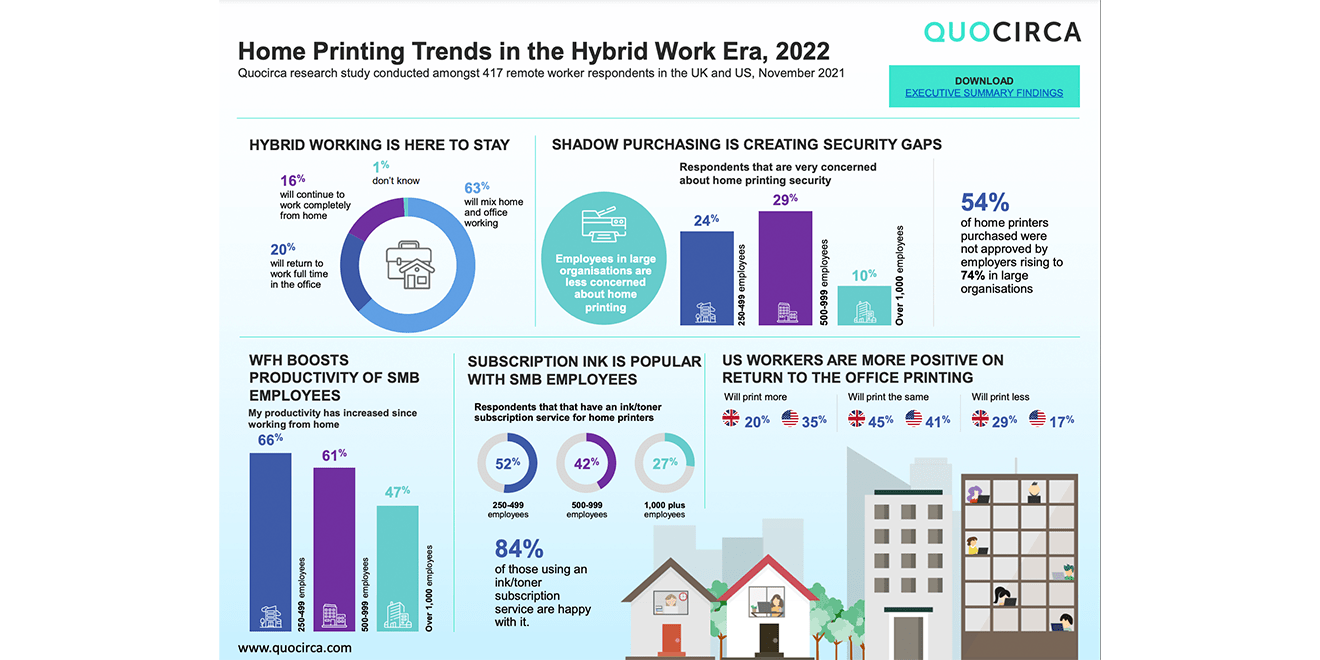Quocirca ‘s latest home printing study finds that SMBs are better at supporting hybrid workers than larger counterparts.
The study found that SMBS are better supporting employees across measures such as employee productivity, security, policies and support for home-based workers, small and mid-sized companies outperformed large enterprises and appear better prepared for long-term hybrid working.
Quocirca surveyed 417 employees from organisations in the UK and US in October 2021. The findings show that hybrid working is becoming the norm. 63% of survey respondents expect to continue mixing home-based and office working for the next 12 months, a rise from 52% a year ago. Only 20% expect to return to full-time office working and this figure drops to 10% among large businesses, where 26% expect to continue working completely from home. This will have ongoing implications for office printing as offices operate at lower capacity with a shift from centralised to distributed office spaces.
Key findings include:
- Home-based workers report increased productivity
58% of respondents say productivity has increased since working from home. The effect is greater in small and mid-sized businesses, where 66% and 61% report increased productivity, respectively. In comparison, only 47% of respondents from enterprises with more than 1000 employees said they were more productive working from home. This may be due to the larger companies relying on larger teams to collaborate effectively. They may also have more legacy processes making it harder to digitise as rapidly as smaller, more agile organisations. If large enterprises are to succeed with hybrid working, they must urgently address these issues to better support the remote workforce. - Shadow printer purchasing is creating security vulnerabilities
54% of respondents say the printer they use at home is not a device recommended or approved by their employer; this figure rises to 74% in large enterprises. Only 21% of respondents say they are very concerned about home printing security, dropping to just 10% in larger organisations. This lack of security awareness points to a disconnect between corporate IT departments and employees, particularly in large businesses. - Small and mid-sized companies are more likely to be addressing home worker print requirements and security issues
14% of small businesses provided employees with a printer to support home working, compared to just 4% of large companies. Across every security measure surveyed, small and mid-sized companies were more likely have it in place. These include: security training; BYOD policies; restrictions on document use; tracking of print use in home/remote environments; guidelines on secure document disposal.
29% of respondents from large enterprises said there were no document security measures in place at all, compared to 10% of small and 11% of mid-sized company respondents. - Home print volumes are rising
63% are printing more at home than they were a year ago, with respondents from small and mid-sized companies more likely to report significant printing increases compared to employees in large enterprises. 56% say they need to print documents for signature or archive, while 43% print because they prefer paper documents. - Growing interest in ink subscription services
40% of respondents have an automated ink/toner delivery service in place and a further 43% who don’t currently have one would be interested in getting one. 52% of respondents from small organisations have a subscription in place, compared to only 27% among larger companies. Large organisations should act urgently to better control and automate supplies provision for their workforce. - Mixed views on return to office printing
Respondents have mixed views on return to office printing. Overall, on their return to the office, 23% of respondents expect to print less than they did before the pandemic. 43% expect to print the same amount, with 28% saying they’ll print more. US respondents are more optimistic about increased office printing post-pandemic – 35% compared to 20% in the UK.
Quocirca said these findings point to a two-speed transition to hybrid working, where small and mid-sized companies are accelerating away from larger, less agile businesses. They are more proactive about addressing security issues and are providing more support for home workers, who in turn report higher productivity. Employees in larger companies feel less productive than their SMB counterparts, which is concerning because this group is the most likely to continue working from home.
This creates an opportunity for channel companies to offer tailored support to newly hybrid organisations to help them transition securely and cost-effectively. MPS providers should be developing services that incorporate home device and consumables provision, along with digital workflow automation tools, particularly for enterprise customers.
Quocirca’s Home Printing Trends and Opportunities Report provides detailed analysis of the transition to hybrid working and key recommendations for buyers and suppliers. Find out more here.























